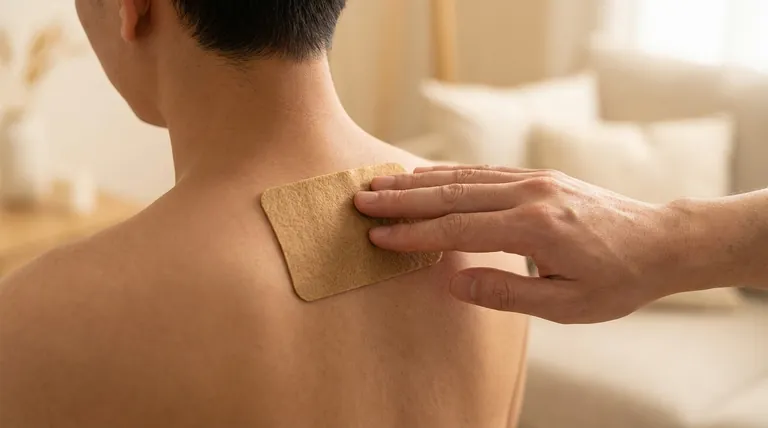The short answer is that rotigotine transdermal patches are primarily used to treat the symptoms of two specific neurological conditions. These are Parkinson's disease (PD) and Restless Legs Syndrome (RLS). The patch delivers the medication steadily through the skin to help manage the distinct challenges associated with each disorder.
Rotigotine treats these conditions by acting as a dopamine agonist, supplementing the brain's natural dopamine activity. The transdermal patch delivery system is a key feature, designed to provide continuous, stable medication levels that oral pills may not.

How Rotigotine Works for Parkinson's Disease (PD)
Parkinson's is a degenerative brain condition where the loss of dopamine-producing cells leads to significant motor control issues. Rotigotine helps compensate for this deficit.
Targeting Core Motor Symptoms
The patch is prescribed to manage the primary signs and symptoms of PD. This includes the characteristic shaking (tremors), muscle stiffness, and slowed movements.
Improving Balance and Stability
By providing steady dopaminergic stimulation, rotigotine can also help address problems with balance, which is a common and challenging symptom for those with Parkinson's disease.
Addressing Restless Legs Syndrome (RLS)
RLS is a neurological condition characterized by an overwhelming and uncomfortable urge to move the legs, disrupting rest and sleep.
Managing Neurological Discomfort
The condition causes significant discomfort, which rotigotine helps to alleviate. Symptoms are often most pronounced at night or during periods of rest, such as sitting or lying down.
Relieving the Urge to Move
As a dopamine agonist, rotigotine helps regulate the nervous system signals that create the strong, often irresistible urge to move the limbs, thereby improving quality of life and sleep.
The Advantage of the Transdermal Patch
The delivery method is as important as the medication itself. Physicians often choose this treatment specifically because it is a patch.
Continuous, Stable Dosing
Unlike oral medications that can cause peaks and troughs in drug levels, a transdermal patch provides a continuous and stable supply of rotigotine. This consistency is critical for managing persistent neurological symptoms.
The Pharmaceutical Form
The patch form itself is a primary reason for its prescription. It offers a convenient, non-invasive way to ensure consistent medication delivery over a 24-hour period without needing to remember multiple daily pills.
Understanding the Trade-offs
While effective, the transdermal patch system has specific considerations. The most common side effects are related to either the dopaminergic stimulation or the patch application itself.
Common Side Effects
Side effects associated with the medication are typically mild to moderate in intensity. These are common among dopamine agonists and are a known factor in treatment.
Application Site Reactions
Because the medication is delivered through the skin, reactions at the patch site can occur. This is a direct trade-off of the transdermal delivery method.
Making the Right Choice for Your Goal
The decision to use a rotigotine patch is based on balancing symptom control with the unique benefits of a transdermal system.
- If your primary focus is managing the motor symptoms of Parkinson's Disease: The patch offers continuous dopamine stimulation to help reduce shaking, stiffness, and slowed movement throughout the day and night.
- If your primary focus is alleviating the disruptive symptoms of Restless Legs Syndrome: The patch provides consistent relief from the persistent discomfort and urge to move, particularly during periods of rest.
Ultimately, the rotigotine transdermal patch offers a specialized approach to managing PD and RLS by combining a proven medication with a steady, continuous delivery system.
Summary Table:
| Condition Treated | Primary Symptom Relief | Key Mechanism |
|---|---|---|
| Parkinson's Disease (PD) | Tremors, stiffness, slowed movement, balance issues | Dopamine agonist, compensating for dopamine loss |
| Restless Legs Syndrome (RLS) | Urge to move legs, discomfort at rest, sleep disruption | Dopamine agonist, regulating nervous system signals |
Need a reliable supplier for transdermal patches?
As Enokon, a bulk manufacturer of reliable transdermal patches and pain plasters, we provide healthcare and pharma distributors and brands with the technical expertise for custom R&D and development. Let us help you bring effective treatments like rotigotine patches to market.
Contact our experts today to discuss your project requirements.
Visual Guide

Related Products
- Far Infrared Heat Pain Relief Patches Transdermal Patches
- Herbal Eye Protection Patch Eye Patch
- Heating Pain Relief Patches for Menstrual Cramps
- Icy Hot Menthol Medicine Pain Relief Patch
- Menthol Gel Pain Relief Patch
People Also Ask
- What types of pain can the Deep Heat Pain Relief Back Patch be used for? Targeted Relief for Muscles & Joints
- What did the UK Million Women Study find regarding transdermal versus oral hormone therapy? A Safer Choice for Gallbladder Health
- What are the key features of the Deep Heat Pain Relief Back Patch? Get Up to 16 Hours of Drug-Free Relief
- How do Deep Heat Pain Relief Patches provide pain relief? Discover the Drug-Free Mechanism
- How does the Deep Heat Back Patch work? A Drug-Free Solution for Targeted Pain Relief













